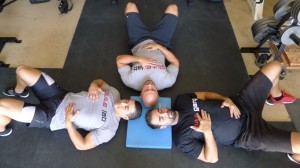When someone looks to get started with a health and fitness routine it's always interesting where they put the emphasis. Do they put most of their focus and effort on the training? Do they train as frequently and intensely as possible? Do they put their efforts into their nutritional plan? Do they make most of their meals? Drink more water? Do they focus on getting their sleep in order? Do they get to bed and get up at the same time daily? There are lots of things that will lead to a positive result. But often times we skip the one thing that is the most basic and can have a huge impact on results. Think back to the first thing and the last thing we'll do in this world. And that's breathing. Breathing is vitally important to everything we do. Yet it gets skipped over or forgotten completely. Which is surprising when we consider we can't go 3 minutes without it. Below are 4 quick ways we can use breathing to help our training or sports performance 1. Calm Our Nerves[caption id="attachment_5313" align="aligncenter" width="300"] Imagine trying to shoot a target with a racing heart rate. Think of the number of sports that require accuracy and precision. Imagine having to make an 8 foot putt in order to win a PGA tournament. Or having to make a couple of free throws with no time on the clock in order to win a basketball game. Or, the one I think that would the toughest, would be having to shoot targets from a standing position in a biathlon race.With all of these there would be benefit to slowing the breathing pattern and calming the nerves before having to perform. 2. Increase MobilityThese days everyone is looking to increase their mobility. They want to have greater stride length as a sprinter. They want to have greater shoulder...
How to Recover More Quickly
- Chris Collins
- Fitness
- Training
- Work-Out Recovery
- 1811 Hits
- 0 Comments
-
I've written before about the importance of breathing on this blog. But a recent session with a client caused me to think it may be worth revisiting. The session I am referring to was with a young client who was doing a vertical load of resistance exercises. This basically means he would do one exercise, move to a different second exercise and finish with a third exercise before taking a rest. This is different from horizontal loading, which is seen in many big box gyms, and involves doing a set of a particular exercise, resting for the prescribed amount of time, then repeating this to complete all the sets before moving on to the next part of the training session. Not only does vertical loading allow for greater workout density it also allows for greater intensity. You can train more intensely because you have more time from one lift until you repeat that same lift again. There are two other exercises plus a rest break before completing the next set of the same exercise. But this post isn't about program design. Instead it's to illustrate the importance of proper breathing during training. Now as you can imagine doing a workout of this type your heart rate will begin to climb. And if you are a little bit deconditioned, tired, under-fueled, dehydrated, stressed or coming down with a cold your heart may have to work a little harder than normal to do the task at hand. And as your heart rate climbs and you try to push yourself you may find you aren't recovering adequately to maintain the intensity and pace of your workout. Since safety precedes results you need an option here. Here's what we did for this client that helped him complete not only this set but the rest of...
Train Smarter Not Harder
- Chris Collins
- Fitness
- Training
- Injury Prevention
- 1965 Hits
- 2 Comments
-
There seems to be a theme in fitness these days regarding intensity. Check out any number of YouTube videos or social media updates and they all seem to be tagged with descriptions of beast mode, strong is the new sexy or something similar. [caption id="attachment_4164" align="alignleft" width="236"] Seek results not soreness. Add to this the popularity of obstacle course racing where the greater the chance of serious injury the more people talk about it. Now no one seems to bat an eye to hear you've done a 10 km race. Unless it involved electrocution, possible hypothermia and challenged you completely in all areas physically. And for the right person at the right stage of their training this can be a great thing. But there are a lot of conditions attached there. This is not something for the person just getting started in fitness or is not already training regularly with a high level of intensity. So while you want to push the intensity and challenge yourself make sure you aren't overdoing it from the get-go or getting strong-armed into signing up for an event you aren't physically ready for. When you consider the injury rate at a Tough Mudder can be 20% you can quickly appreciate how many people are in over their heads when they step up to the start line. 15,000 at the start line and as many as 3000 injured is not a good statistic. Unless you are a physiotherapist than you may be glad to hear the phone ringing off the hook Monday after an event. So what are you to do? Play it safe and never enter these events? Or can you be a little smarter with your training and still push yourself, get great results and do some fun races? Absolutely you can. And the...
6 Benefits of Proper Diaphragmatic Breathing
- Chris Collins
- Fitness
- 2318 Hits
- 4 Comments
-
There's been lots of discussion recently regarding diaphragmatic breathing. Some people are aware of the benefits of this type of breathing and others are probably thinking 'what's the big deal?' At a recent conference in California one of the more veteran presenters at a round table discussion said he didn't understand the big deal everyone was making about breathing. And I can kind of see his point. Sometimes we can get caught up in the minutiae of training and lose focus on the big picture. But in this case breathing is the basis for everything we do. It provides feedback as to the state of our nervous system, the effectivenss of our gas exchange and whether we are leaving anything on the table during athletic performance. But it's more than that. Because 20, 30 or 40 years ago we didn't sit and drive as much as do today. And we didn't specialize in one sport or activity as much as we see going on today. And maybe we lived simpler lives and didn't carry all of the stress that we do now in 2013. So we would therefore expect there to be differences in our posture, our mobility, the type and severity of the injuries we suffer as well as how much stress we are under. As a result there would be benefits to ensuring that we are breathing properly. In fact below are 6 Benefits of Proper Diaphragmatic Breathing. Diaphragmatic Breathing Benefit #1 - Better Gas ExchangeInstead of breathing maybe we should say respiration because with every breath we take in oxygen and exhale carbon dioxide. If we repsire, as many people do thoracically, we see the shoulders rise up towards the ears and the neck and traps contract. ***quick aside...The new Twilight movie involves the main character Bella getting...


